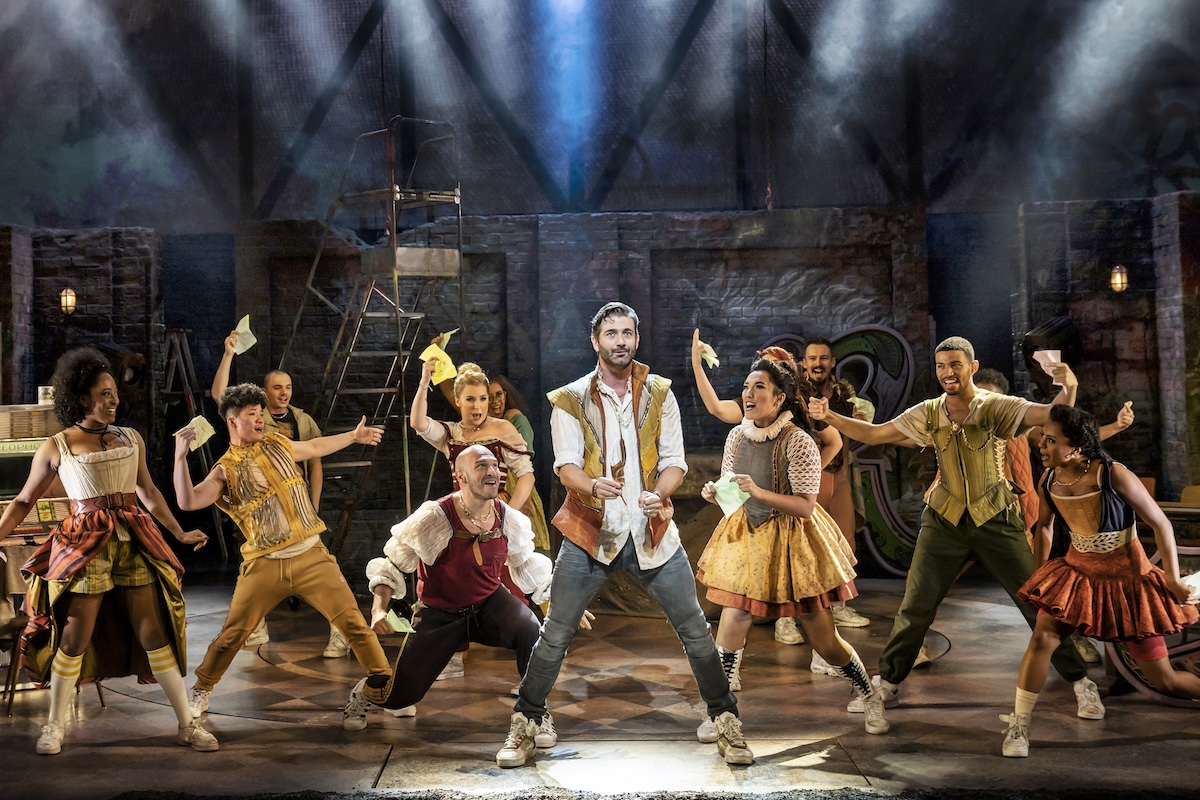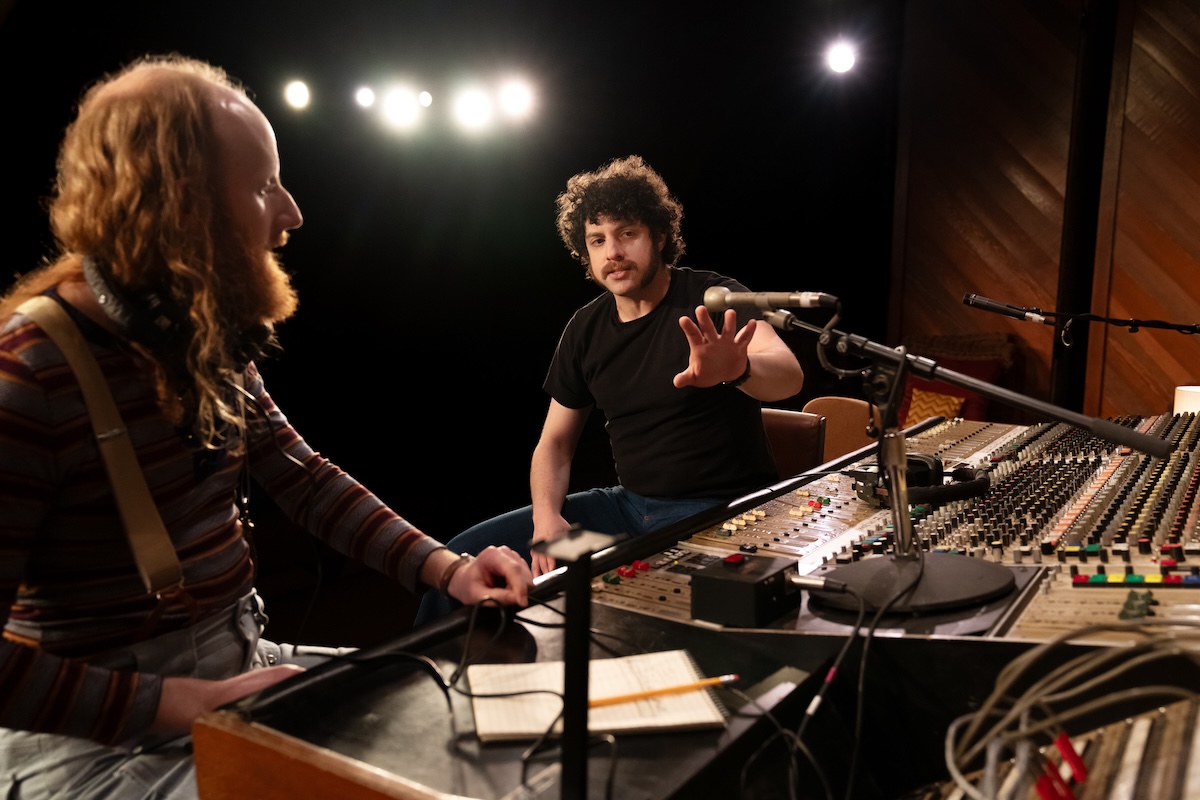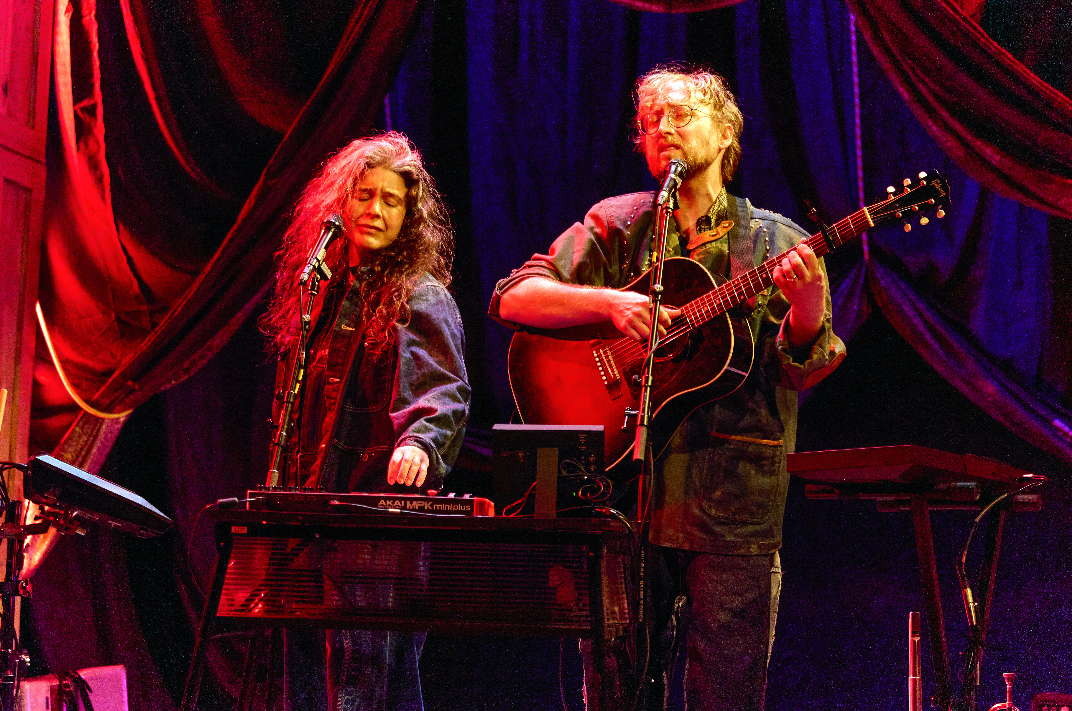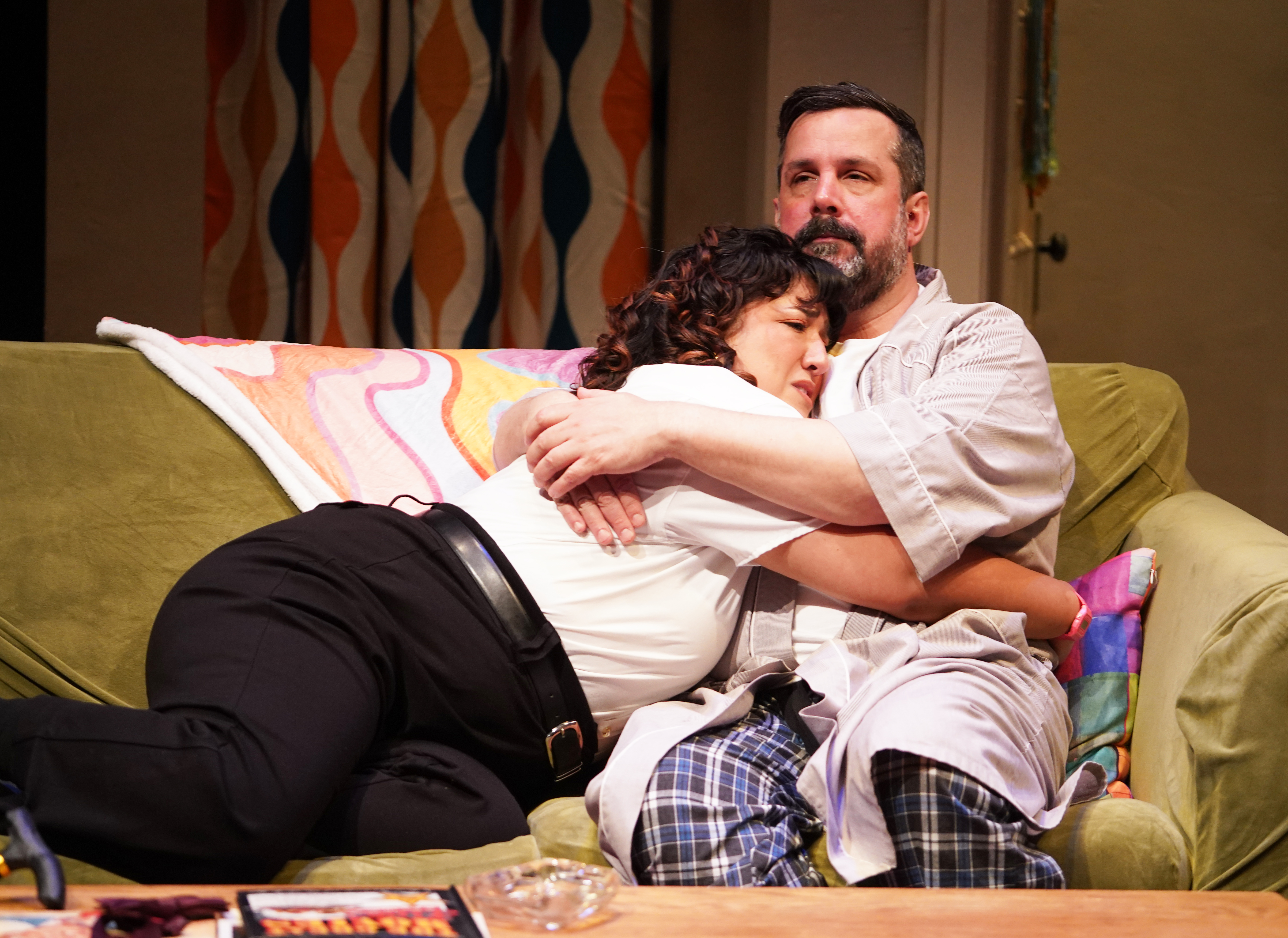La Bohème

Alfred Boe and Wei Huang in La Bohème
(Photo: Sue Adler)
The very idea of presenting an Italian opera on Broadway is so deliciously odd and exciting that the temptation is to expound on What It All Means, but most of this territory has already been covered in countless reams and megabytes worth of words written about Baz Luhrmann’s La Bohème in the weeks leading up to its opening last night. Now that Bohème has officially bowed at the Broadway Theatre, any review that focused on the whys and wherefores of the production would be redundant. Better to cut to the chase and say that, on its own terms, the show succeeds brilliantly.
Not all of the production’s innovations relate to the updating of the action or to Luhrmann’s “let’s put on an opera” conceit; some of the ideas set forth here would be equally effective in a traditional Bohéme. The most stunning example of this has to do with the key to Mimi’s flat. You’ll remember that she drops the key after knocking on Rodolfo’s door to ask him to relight her candle, all of which leads to an intense case of love at first sight. In the final scene of Luhrmann’s Bohème, as the lovers recall their first meeting while Mimi lies dying, Rodolfo produces the key — which, it turns out, has been hanging on a string around his neck all along. At this moment in the performance I attended, David Miller (Rodolfo) and Ekaterina Solovyeva (Mimi) almost seemed to be weeping — as was the audience, needless to say.
When Bohème is performed in venues like the 3,800 seat Metropolitan Opera House — where, as a friend of mine says, even some of the best seats are a car ride away from the stage — it’s fairly easy to pretend that the soprano and tenor are young and beautiful lovers, even if they’re actually stout and/or well into their 50s. At the Met, vocal ability is paramount and everything else is far less important. But this is not the case in the more intimate confines of a Broadway theater — not even one as large as the Broadway Theatre. At the risk of sounding superficial, it must be said that the exceptional good looks of Solovyeva and Miller (and, from what I’ve seen at preview events, the production’s alternating Mimis and Rodolfos) add as much to this production as their excellent singing and acting. The pair’s first scene together is suffused with sexual tension hot enough to warm Rodolfo’s freezing garret. And when the moonstruck lovers climb up to the roof to sing “O soave fanciulla” before a huge red sign extolling “L’amour,” the visual beauty of the scene is as heart-stopping as is the ecstatic music. (Andrea Bocelli had better watch out; David Miller, blessed with a far superior voice and much nicer to look at, could give that fraud a run for his money.)
Equally attractive in vocal, visual, and dramatic terms are Eugene Brancoveanu as Marcello and Jessica Comeau as Musetta. Whether cat-fighting with his erstwhile girlfriend or commiserating with his roommate, Brancoveanu is always focused and “in the moment.” Comeau is quite the sexy spitfire — especially in her waltz song, Bohème‘s biggest hit tune — but she also communicates the character’s sense of humor better that any previous Musetta I’ve seen in 25 years of operagoing. All of the leads’ voices allow them to project their characterizations to the back rows of the theater even as their superbly naturalistic, film-style acting is appreciated by folks seated closer to the stage. [For more on Brancoveanu and Comeau, as well as a report on the other Musetta-Marcello pairing and the two other sets of Mimis and Rodolfos, see Barbara & Scott Siegel’s review below.]
The principals receive stalwart support from the other bohemians, Daniel Webb as the philosopher Colline and Dainel Okulitch as the musician Schaunard. These two are especially impressive in the final scene, where they really seem to be roommates witnessing the death of a friend rather than actors performing on the stage of a Broadway theater in front of nearly 2,000 people. Marvelously detailed character sketches are also provided by Adam Grupper as the vexed landlord Benoit and William Youmans as a painfully British Alcindoro — so British that he actually sings a few lines in English.
The excellence of the supertitles — or, if you prefer, surtitles — used for the production should not go unremarked. Although La Bohème is a timeless work, its libretto (as opposed to its music) can strike modern ears as quaint, and it’s no easy task to modernize the language without betraying the original intentions of Giuseppe Giacosa and Luigi Illica. In Act II, there’s a memorable moment when Rodolfo introduces Mimi to his roommates in a famous musical passage filled with flowery metaphors. Marcello responds sarcastically with “Dio, che concetti rari!” which might be literally translated as “Lord, what rare fancies!” The translation here: “What magnificent bullshit!” When the bohemians set fire to Rodolfo’s play in order to keep themselves warm, Marcello laments the dying of the flame by singing a line that would be rendered word for word in English as “It crackles, withers, die!” but here is translated as “Going, going, gone!” The titles also sidestep one or two phrases in the libretto that might be considerd politically incorrect by current standards. For example: When Mimi skittishly pulls away from Rodolfo after the climax of “O soave fanciulla,” he sings “Sei mia,” which would be most accurately translated as “You’re mine” but is here surtitled as “What’s wrong?”

David Miller and Ekaterina Solovyeva
(Photo: Sue Adler)
Strangely, though the titles are essential to the success of this production, their authorship is not noted on the title page of the Playbill; you have to look much further back, to the “Staff for La Boheme” section, to find that they are credited to Luhrmann, David Crooks, and Jerry Ruiz from an original draft by Roberto Bernabib. In a director’s note, Luhrmann tells us that the singers also had a hand in distilling the original Italian into “the spirit of what was being said using a 1950s vernacular,” including such expressions as “daddy-o,” “man,” and “where it’s at.” (By the way, the titles cannily make use of varying typefaces in order to clarify who’s singing what in some of the opera’s busier ensembles.)
The musical values of the show are praiseworthy. Though the orchestra is, at most, half the size of the forces you’d encounter in a production of Bohème by a major opera house, it’s still considerably larger than the typical Broadway pit band these days; to my ears, only the violin section sounds a bit undernourished. Musical director and principal conductor Constantine Kitsopoulos paces the score beautifully and keeps the ensemble together (though, at the performance I attended, the Parpignol chorus in the Café Momus scene went awry due to the overenthusiasm of some of the kids singing it).
A vocal minority of filmgoers — myself included — deplored Baz Luhrmann’s Moulin Rouge for a number or reasons, not least its frenzied editing and the crazy quilt aspect of its musical selections. But, whatever its flaws, that film did allow its central characters to sing of romance in a passionate, sincere, non-ironic way — something you won’t find in Urinetown or The Producers, or even in Chicago. The new Bohème has a couple of pop culture references: Brando and Christian Dior are invoked, and a brief choreographic hommage to West Side Story delights the audience. But, thank heaven, Luhrmann and company take the opera seriously.
If the show has a flaw, it’s that so much is going on at once. Between the singing, the acting, the stage business, the sets, the costumes, and the titles, this production should ideally be seen two or three times to get its full effect. And that’s fine, because each return visit to Baz’s Boheme promises to be a total pleasure.
— Michael Portantiere
********************
Call him “The Wizard of Baz”: Australian director Baz Luhrmann has brought brains, heart, and courage to Broadway with his stunning production of La Bohème.
Let’s settle something right from the start. As far as we’re concerned, opera is just a different form of musical theater than what we’re used to seeing on the Great White Way. Now that La Bohème has opened at the Broadway Theatre, there are two shows in town that tell the same story — well, almost the same story. Puccini and his librettists had the guts to end their tale tragically; Jonathan Larson ends Rent, based on Bohème, with a sell-out moment of relief and happiness. Of course, Rent is selling out in the other sense of that term. Luhrmann’s presentation of the opera with its sorrowful final scene intact is just one of the reasons why his gamble is so gutsy.
On the surface, bringing an opera to Broadway — even one as beloved and well known as this one — is risky business. That’s where the brains come in. Luhrmann has directed the production so that we witness the artifice of his art. Then, with bold strokes, he makes us forget the fakery as we are swept up in the illusion he creates. Like Penn & Teller, Luhrmann tells you how the “trick” works — and then he goes ahead and does it anyway. Note the way in which he handles the scene change between Acts I and II: Instead of closing a curtain, he has stagehands come out and move the sets while several principal characters have their makeup applied by assistants in plain view of the audience. Slowly, all of the performers — and dozens of them are on stage at the start of the second act — take their positions. Then, almost like a flash from a camera, the lighting changes and music fills the theater. Suddenly, Act II begins like a photo coming to life. We are privy to the creation of the scene and it’s thrilling to watch.

Lisa Hopkins and Jesús Garcia
(Photo: Sue Adler)
A hip translation of the libretto is delivered to the audience by way of the production’s supertitles. The story is the same as always but now takes place in 1957. Though Mimi dies at the end of the opera, she and the rest of characters have Puccini in their corner, and he has saved them all from death lo these many years. The music of La Bohème is gorgeous: lush, melodic, emotionally engaging.
We saw and heard two of the three different sets of Mimis and Rodolfos, and both sets of Musettas and Marcellos. Each performer is noticeably different from his or her alternate(s) but, happily, there is no sharp diminution from one cast to the next. Jesús Garcia displays a beautiful tenor and a languid sensuality as Rodolfo while Alfred Boe in the same role offers a more vibrant vocal tone and approaches the part more aggressively. Boe’s version of the character is active while Garcia’s is more reactive. Both choices are valid. Garcia is usually partnered with the Mimi of Lisa Hopkins, whose makeup in her first scene is downright scary — and so is her acting. Clearly, she was hired for her warm soprano. Performing Mimi opposite Boe is Wei Huang, who acts as wonderfully well as she sings.
One of the great pleasures of La Bohème is the semi-comic subplot concerning the tempestuous romance between the painter Marcello and the worldly coquette Musetta. Both of this production’s teams in those roles are up to snuff, but we give the edge to Eugene Brancoveanu and Jessica Comeau over Ben Davis and Chloë Wright. Brancoveanu is, in fact, the best actor among all of the leads we saw, offering much texture and shading in his characterization aside from his rich and expressive baritone; though Marcello is hot-headed and displays several other faults, Brancoveanu makes him charming and likeable. Comeau is deliciously saucy as Musetta, sparkling so brilliantly that we understand why her guy is nuts for her. In the other pairing, Davis plays Marcello solidly but with less verve than Brancoveanu — though he, too, has a smooth and commanding baritone. His Musetta, the buxom Wright, plays the role like a 1950’s movie star and sings it beautifully.
So, which cast to choose? See them all! We certainly want to catch the third Mimi/Rodolfo pairing. The great news is that this production can sustain being seen again and again. Aside from its other assets, Catherine Martin’s designs are fundamentally and excitingly theatrical.
Baz Luhrmann directed Moulin Rouge, which grossed more than $300 million in movie theaters worldwide. Why, in filthy lucre’s name, did he decide to bring an operatic warhorse to Broadway? Clearly, he has a passion for the project that goes beyond monetary considerations. That’s where the heart comes in. Luhrmann has publicly stated that he wants to broaden the appeal of opera — and he is doing just that. He and his colleagues have given us a Bohème that does not intimidate. Rather, it entertains us even as it breaks our hearts.
— Barbara & Scott Siegel










